Disclosure: Meeple Mountain received a free copy of this product in exchange for an honest, unbiased review. This review is not intended to be an endorsement.
What is mandala? Mandala is the Sanskrit word for ‘circle’. Used in Hinduism and Buddhism as a spiritual symbol, the circular nature of the mandala represents the universe and the interconnectedness of all things. A mandala circle is also a representation of the spiritual journey within the viewer. And, as demonstrated by this game, they’re also very pretty to look at.
Overview
Mandala Stones is an abstract game that has the players moving Artist pawns around a board filled with brightly colored, circular tiles to collect the titular mandala stones. The stones are collected in stacks and the stacks are added to the player’s board where they will later be scored. As stones are scored, they are removed from the player’s board and added to a central mandala board where they begin to form a spiraling design. Once a certain number of stones have been added to the board, the game comes to an end and the person with the highest score wins.
Of course, this is an oversimplification. If you’d like to know more about how the game is played, then continue reading. Otherwise, feel free to skip ahead to the Thoughts section to find out what I think of Mandala Stones.
He Picks…
During setup, stacks of randomly drawn stones are created and placed on the Main board along with the four Artist pawns. Each stone features 1 of 2 possible mandala illustrations as do the Artist pawns. The players also receive their personal Player boards with their score markers set to 0, a player aid, and 2 randomly drawn Objective cards.
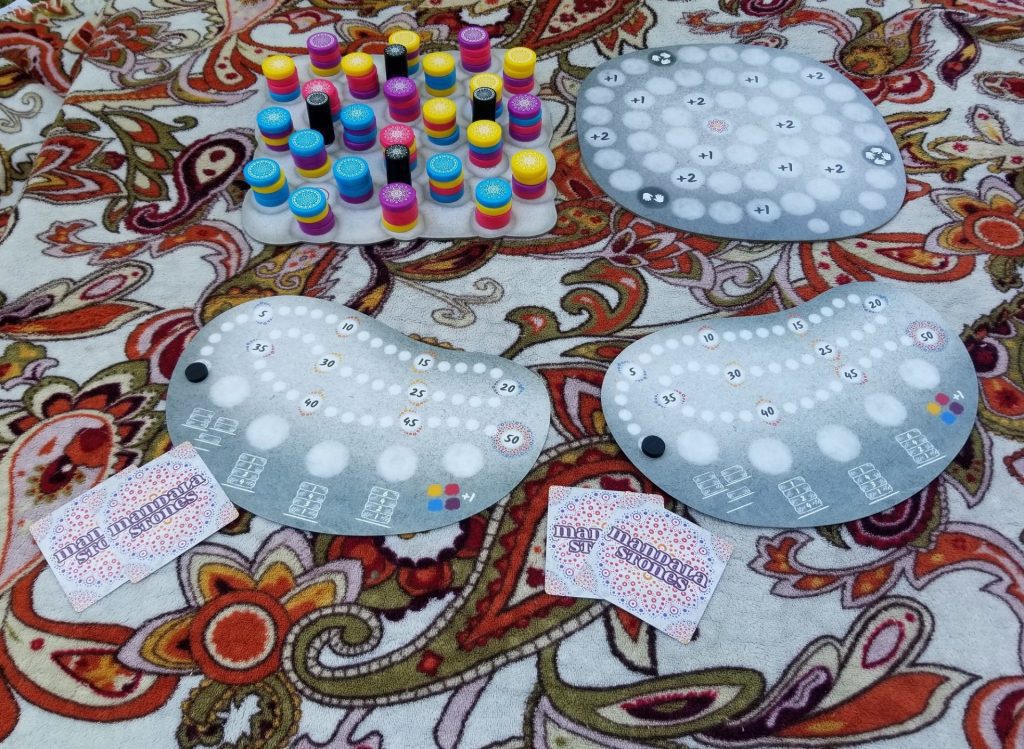
The Player boards have a score track running along the tops of them and five scoring locations shown along the bottom. From left to right, they score as follow:
- Points scored for each differently sized stack on the Player board
- Points scored based on the top stone’s position
- Points scored based on the top stone’s position
- Points scored based on the top stone’s position
- Points scored for the number of differently colored stones in the stack
This is important to keep in mind when we’re discussing the role of the Artist pawns.
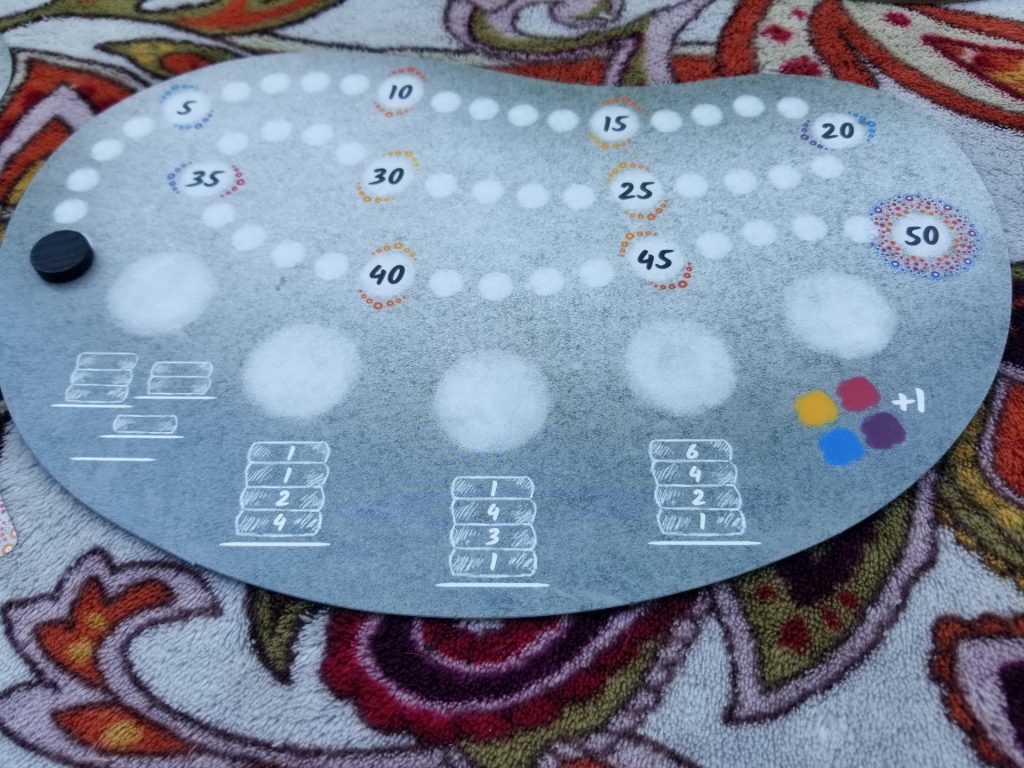
The Artist pawns are how you collect stones. On your turn, 1 of your 2 available options is to PICK stones. Choose an Artist pawn and move it to an empty space between several stacks of stones. Then collect all the stones whose mandala illustrations match that of the Artist pawn. You can begin by collecting any stone of your choice, from the top of a stack, but each stone collected thereafter must be collected in clockwise order from whichever stone you collected first. The first stone is placed at the bottom of the stack and each subsequent stone is placed atop whichever stone is on top. At most, you will only ever collect 4 stones, one from the top of each stack.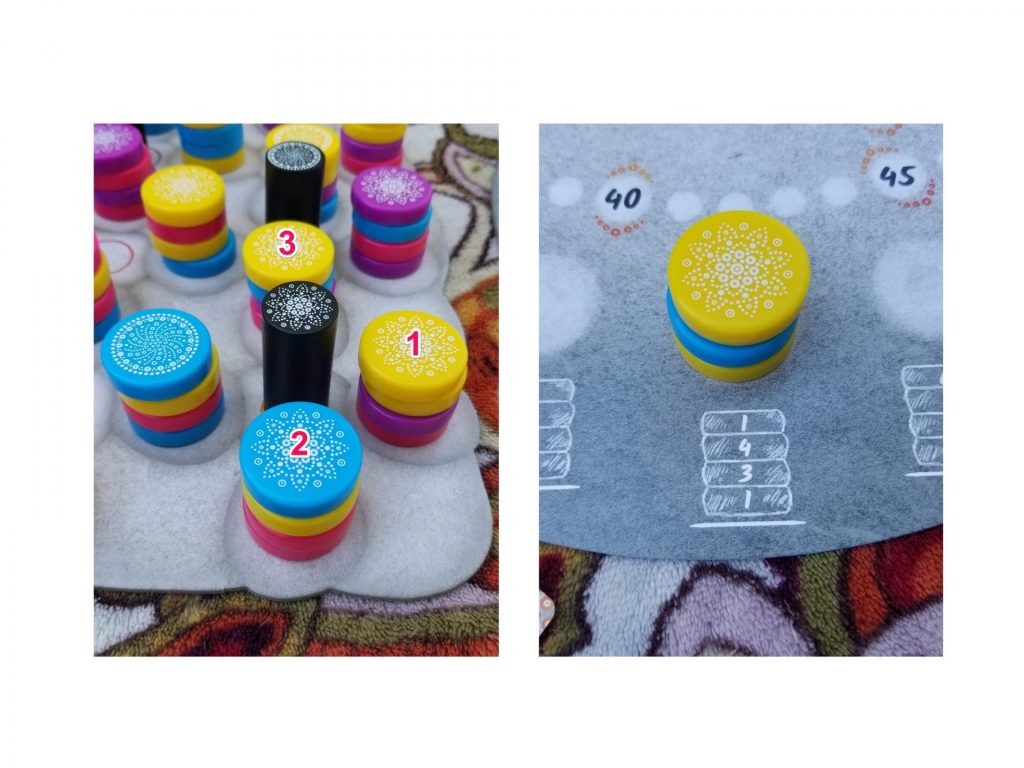
There’s a small catch, though. If any of the stones are adjacent to more than 1 Artist pawn, they cannot be collected. Once you’ve collected a stack of stones, then you will assign the stack to one of the 5 scoring locations on your player board.
… He Scores!
If, at the beginning of your turn, all 5 scoring locations are filled, then you must perform the second of your options, SCORING. Scoring can also optionally be performed even if there are empty scoring locations available. When scoring, you can choose to score a color or score any top stones.
To score a color, select at least 2 stacks that have matching colored top stones. Then score these from left to right, based on the scoring criteria of the locations of the stack. As each stack is scored, remove the top stone from it and set it aside. Once you’ve finished scoring your stacks, place the removed stones onto the Mandala board. Generally, the more scoring locations you are able to score in a single scoring, the better off you’ll be.
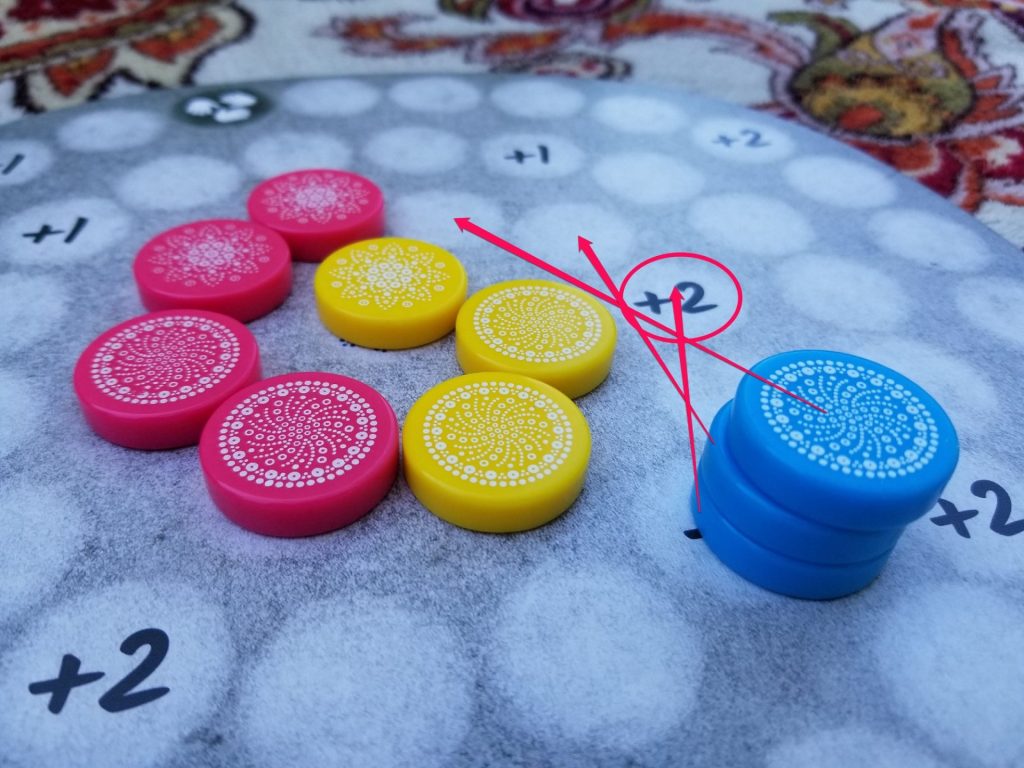
Scoring top stones is as easy as removing any top stones of your choice, setting them aside, and scoring a single point for each removed stone before adding them to the Mandala board. This doesn’t score you many points, but sometimes removing top stones is a great way to set yourself up for a much larger scoring opportunity later on.
Occasionally, adding a stone to the Mandala board will cover up a number printed there. Covering these numbers scores you bonus points equal to the covered up number. It’s usually not a good idea to score unless you can cover these numbers yourself, but sometimes you just won’t have a choice.
Closing the Circle
The game will end in 1 of 2 possible ways: after a certain number of stones have been added to the Mandala board (determined by player count) or when any player is unable to PICK or SCORE. In the case of the former, the game ends at the end of the round in which the end game was triggered. In the case of the latter, the game ends immediately.
Once the game is finished, each player will reveal their Objective cards and choose 1 of them to score if they are able. Then the player with the highest total wins.
Thoughts
When Mandala Stones arrived on my doorstep and I opened it for the first time, I asked myself what I was thinking. Aside from the striking artwork, there was nothing about Mandala Stones that I could identify right away that would have made me raise my hand and volunteer to review it. I am not a religious or spiritual person, so the theme doesn’t speak to me. It’s a game from a designer I have never heard of, so that wasn’t it. And, generally, I am not a fan of abstracts. If I’m being honest, I was sort of regretting my decision before I’d even played the game.
But first impressions aren’t always correct. Given the chance, I find that sometimes a thing I am usually diametrically opposed to has a way of surprising me. The first time I laid eyes on Cobra Paw, for instance, I was not impressed and I agreed to play the game largely to appease my wife. I was shocked by how much I enjoyed it. Review writing lesson learned: don’t judge a book by its cover. I’m glad I gave Mandala Stones a chance.
Mandala Stones, physically, is a very attractive game. The soft color palette with its vibrant purples, pinks, yellow, and blues was a wise choice. The game is visually tranquil and that plays well with the theme–a theme which is pretty much lacking everywhere else. If I’m being honest, thematically I have no idea what’s going on in this game. For instance, I have a hard time believing that the black cylinders are artists. Maybe it’s just my aversion to abstracts, but the theme here just does not work for me. That’s fine, though, because the gameplay more than makes up for Mandala Stones’s thematic shortcomings.
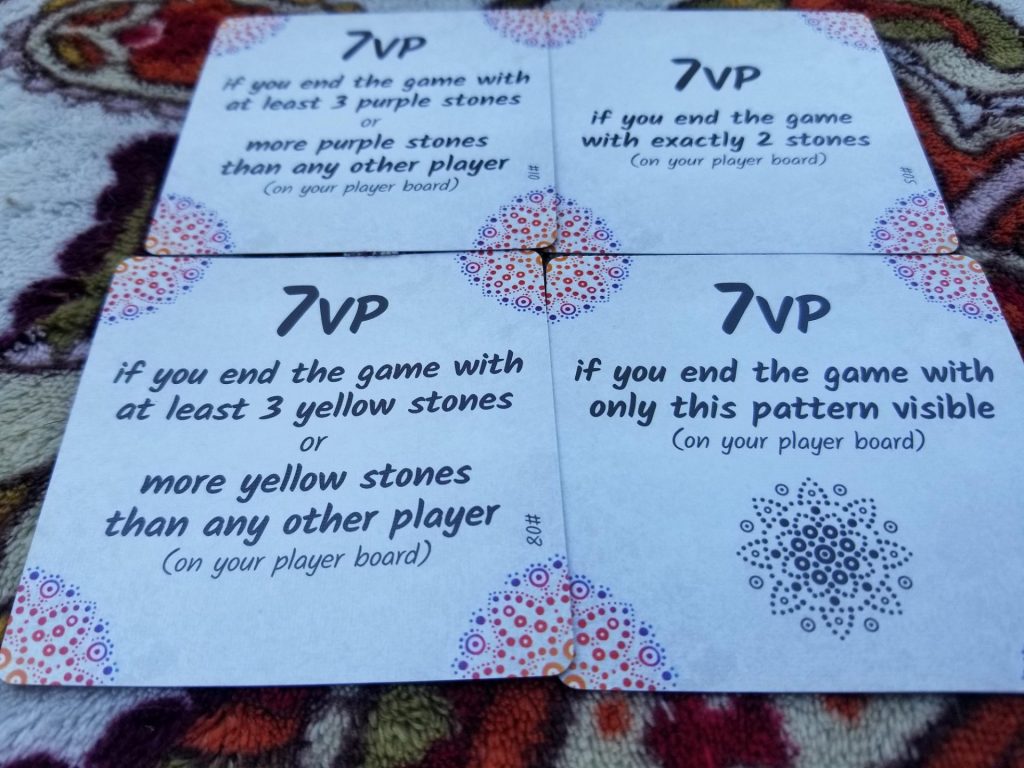
This game is like setting up a series of dominoes, knocking one over, and watching them fall. Done correctly, the resulting cascade is a thing of beauty. Done poorly, even just a single domino slightly out of place, and your elegant crescendo comes to a grinding halt. The puzzle of Mandala Stones is trying to figure out how to set up those dominoes while at the same time ensuring you make it hard for your opponents to set up theirs.
The ideal situation would be to pick up the same color stacks on each of your turns so that, as you peel off the top layers, another scoring layer is presented underneath with another revealed when those top stones are removed, ad infinitum, until you’re left with a bunch of empty spots and need to start picking up stones again. But rarely in board games do we ever get the ideal situation laid out before us. Sometimes in Mandala Stones you just get dealt a lousy hand. None of the artist pawns are situated next to colors you actually want or if they are, there’s another artist pawn sitting next to them preventing you from picking them up. It is in this “making the best of a bad situation” territory where the game really shines.
Sometimes the best thing to do is to just pick up some garbage you really don’t want just so that you can position an artist pawn in such a way to block an opponent from getting something that they want. But can you turn that garbage draft into something useful? It seems like moving a pawn and picking up some stones should be easy, but it rarely ever is. And sometimes the best thing to do is to execute the weakest option in the game, scoring the top stones. Using this option cleverly can net you a few points, steal a bonus from your opponents, and set yourself up for a much better future turn.
So, much to my surprise, I wound up enjoying this game much more than I thought I initially would. In fact, aside from the thematic issues, I have very little negative to say about this game. The only other things I can think of are pretty minuscule. There are a few objectives which refer to red stones even though the stones are pink. This caused confusion in multiple plays, so it’s become part of my teach for the game to point out this inconsistency. The other thing that I find slightly more troublesome is the way that you’re told to stack stones. Every single game that I have played, the players struggle with the “old stones on the bottom and new stones on the top” aspect. I have no idea why this rule is in place. It seems very arbitrary, unnecessary, and counter to the way that you’d typically pick up stones–pick one up, hover over the next in line and pick it up, adding it to the bottom. Then onto the next one.
And that’s really it. Mandala Stones is a pretty good game overall. It hits those same notes that Azul hits for me. So if that sounds like something that appeals to you, you should give this game a try. I’m glad I did.


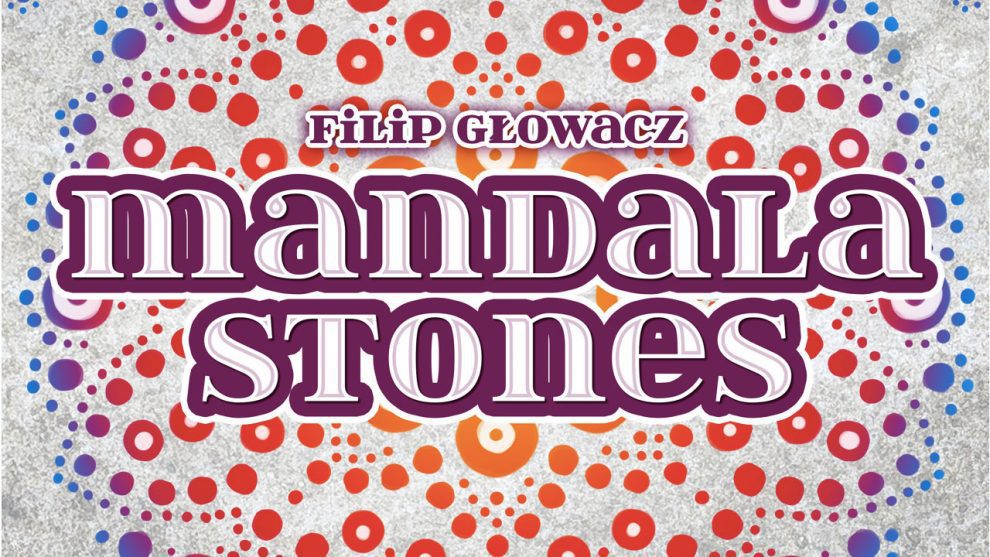









Add Comment